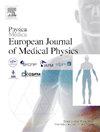A qualitative, quantitative and dosimetric evaluation of a machine learning-based automatic segmentation method in treatment planning for gastric cancer
IF 3.3
3区 医学
Q1 RADIOLOGY, NUCLEAR MEDICINE & MEDICAL IMAGING
Physica Medica-European Journal of Medical Physics
Pub Date : 2025-02-01
DOI:10.1016/j.ejmp.2025.104896
引用次数: 0
Abstract
Purpose
To investigate the performance of a machine learning-based segmentation method for treatment planning of gastric cancer.
Materials and methods
Eighteen patients planned to be irradiated for gastric cancer were studied. The target and the surrounding organs-at-risk (OARs) were manually delineated on CT scans. A machine learning algorithm was used for automatically segmenting the lungs, kidneys, liver, spleen and spinal cord. Two radiation oncologists evaluated these contours and performed the required editing. The accuracy of the auto-segmented contours relative to manual outlines was evaluated by calculating the dice similarity coefficient (DSC), Jaccard score (JS), sensitivity and precision. VMAT plans were initially created on manual contours (MCPlans) and, then, on edited and unedited auto-segmented contours (ACedPlans). Dose parameters of the OARs and target volume derived from the different treatment plans were statistically compared.
Results
The 24.6 % of the auto-segmented contours were acceptable and 40.5 % needed changes related to stylistic deviations. Minor editing was applied in 34.1 % of these contours. The mean values of the DSC, JS, sensitivity and precision associated with the comparison of the manual outlines and the contour set including edited and unedited auto-segmented contours were 0.91–0.97, 0.84–0.94, 0.92–0.97 and 0.91–0.97, respectively. No significant differences were found for fifteen out of eighteen examined dosimetric parameters derived from MCPlans and ACedPlans (p > 0.05). These parameters from the MCPlans agreed well with those from ACedPlans based on the Bland-Altman test.
Conclusions
The qualitative, quantitative and dosimetric analysis highlighted the clinical acceptability of a machine learning-based segmentation method for radiotherapy of gastric cancer.
基于机器学习的自动分割方法在胃癌治疗计划中的定性、定量和剂量学评价。
目的:探讨一种基于机器学习的分割方法在胃癌治疗计划中的性能。材料与方法:对18例拟行胃癌放射治疗的患者进行研究。在CT扫描上手动划定靶和周围危险器官(OARs)。使用机器学习算法自动分割肺、肾、肝、脾和脊髓。两名放射肿瘤学家评估了这些轮廓并进行了必要的编辑。通过计算骰子相似系数(DSC)、Jaccard分数(JS)、灵敏度和精度来评价自动分割轮廓相对于人工轮廓的准确性。VMAT计划最初是在手动轮廓(MCPlans)上创建的,然后是在编辑和未编辑的自动分割轮廓(ACedPlans)上创建的。统计比较不同治疗方案的OARs剂量参数和靶体积。结果:24.6%的自动分割轮廓可接受,40.5%的自动分割轮廓需要改变。34.1%的轮廓进行了轻微的编辑。手工轮廓与编辑和未编辑的自动分割轮廓的DSC、JS、灵敏度和精度的平均值分别为0.91-0.97、0.84-0.94、0.92-0.97和0.91-0.97。MCPlans和ACedPlans的18个剂量学参数中有15个没有发现显著差异(p > 0.05)。MCPlans的这些参数与基于Bland-Altman测试的ACedPlans的参数非常吻合。结论:通过定性、定量和剂量学分析,强调了基于机器学习的胃癌放疗分割方法的临床可接受性。
本文章由计算机程序翻译,如有差异,请以英文原文为准。
求助全文
约1分钟内获得全文
求助全文
来源期刊
CiteScore
6.80
自引率
14.70%
发文量
493
审稿时长
78 days
期刊介绍:
Physica Medica, European Journal of Medical Physics, publishing with Elsevier from 2007, provides an international forum for research and reviews on the following main topics:
Medical Imaging
Radiation Therapy
Radiation Protection
Measuring Systems and Signal Processing
Education and training in Medical Physics
Professional issues in Medical Physics.

 求助内容:
求助内容: 应助结果提醒方式:
应助结果提醒方式:


